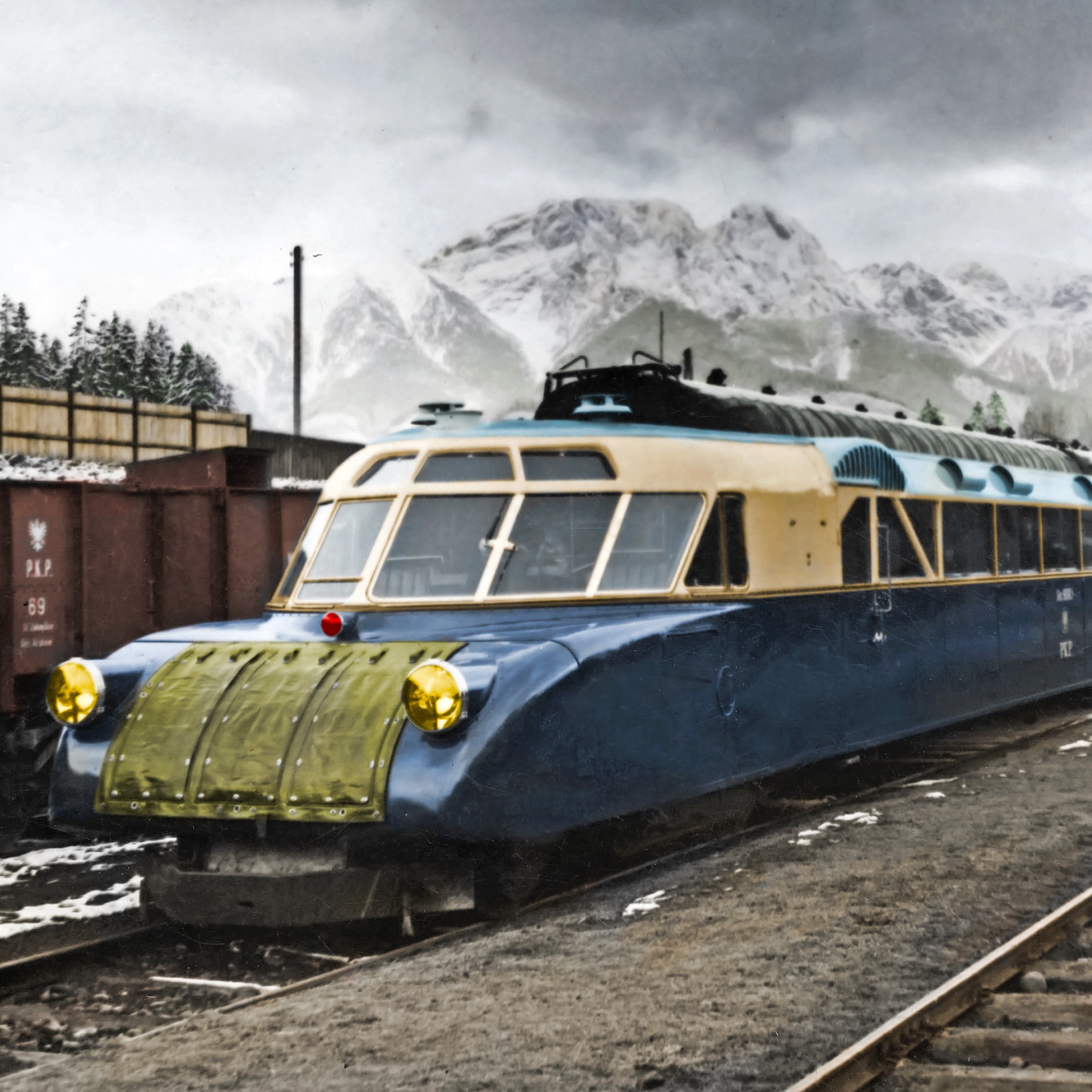
03 Oct Fast, beautiful and made in Poland.
c_row css_animation=”” row_type=”row” use_row_as_full_screen_section=”no” type=”full_width” angled_section=”no” text_align=”left” background_image_as_pattern=”without_pattern”]
When back in 1918 Poland commenced the reconstruction of Polish National Rail the rolling stock mainly consisted of what was left behind by the occupiers. Amongst them was one self-acting single-unit passenger train equipped with a combustion engine. This new design proved to be superior to the traditional steam trains. Polish National Rail began to slowly draft the design for a construction of something that up to this point has been unheard of. Fast self-acting single-unit passenger trains equipped with combustion engines were slowly introduced in the 1930s. Initially they serviced long distance connections with Germany where the majority of large cities were connected by self-acting combustion carriages. The most famous train – “The Flying Hamburger” – connected Berlin with Hamburg, whilst “The Flying Silesian” connected Berlin with Bytom via Wroclaw and Opole.
In order to establish the usefulness of combustion rolling stock within Poland, in 1933 a passenger self-acting single-unit train was leased from the Austro-Daimler-Puch Company. The train was known as the Luxtorpedo. After running all tests, the carriage was purchased and marked with the inventory number PKP SAx 90080. The aim was to start local production of the same type of carriage in order to minimise import costs. Engineer Klemens Stefan Sielecki, who worked at the Fablok Company, was the leader of the design and construction project of the first 5 units of a Polish Luxtorpedo, marked with inventory numbers from SAx 90081 to SAx 90085. The carriages were equipped with a German MAN engine. Polish Luxtorpedoes had much better parameters and a lower purchase and running costs than their Austrian archetypes. The carriages were used on the most prestigious routes, such as Cracow – Zakopane and Cracow – Krynica. In 1936 one of the Luxtorpedoes beat the seemingly unbreakable record on the Cracow – Zakopane route with a travel time of 2 hours and 18 minutes!
The popular Luxtorpedoes were of a luxurious character. Fares were pricey and there were only 1st class seats on board. Luxtorpedoes could not be joined with any other carriages, therefore, there was only a limited number of available seats hence the demand for that type of travel was low. As a result, only a small number of Luxtorpedoes was produced – only five. The sixth existing train of that type was the Austrian archetype purchased in the beginning from its manufacturer.
After the German bombings in September 1939, 4 Luxtorpedoes were destroyed – 2 in Cracow and 2 in Skarzysko-Kamienna. The remaining two machines were used during the occupation as special trains (Sonderzüge) for exclusive use by the German population. They travelled on routes between Cracow – Zakopane and Cracow – Krynica. Hans Frank, the General Governor, would sometimes choose to travel by Luxtorpedoes with his guests when he wanted to impress them with the modern rail transport available in annexed lands.
In 1945 the carriages fell into Soviet hands. When they were finally returned to Polish National Rail their condition did not allow for further passenger use. One of the machines was sacrificed for parts for a similar sister carriage used for carrying miners of the Trzebnia mine. Around 1954 both remaining machines were lost and sent to a scrap yard.
The Alleged Luxtorpedoes
Other self-acting trains would pretend to the name of the Luxtorpedo. Contrary to the original, luxurious Luxtorpedos, they were designed as economy class machines to be used as Motor-Express trains. The “economy” class motor carriages were deprived of the low, streamline shape typical of Luxtorpedoes. Their shape was more classic and crude.
They were constructed following the decision of the Ministry for Transport passed in 1933 on the need to produce for the National Polish Rail four-axis motor carriages capable of a speed of 140km/h and two-axis carriages of a maximum speed of 70 km/h. The first type was to service long-distance connections whilst the latter was to be used more locally. Soon Polish manufacturers of rolling stock (Henryk Cegielski Factory in Poznan, Fablok in Chrzanow, Zieleniewski Co in Sanok, and the Lilpop, Rau and Loewenstein factory in Warsaw) commenced the production of self-acting combustion engine single-unit passenger trains. And so, the “poor relatives” of the true Luxtorpedoes were to swiftly begin their rail career.
Polish combustion-engine carriages were stationed in Cracow, Lviv, Warsaw, and Skarzysko-Kamienna (District Directorate of Polish National Rail in Cracow). Until 1939, the carriages produced in Warsaw could be seen on the following routes:
Warsaw – Katowice and Cracow via Kielce
Warsaw – Katowice via Czestochowa
Warsaw – Lodz.
The time of travel on the latter connection amounted to approximately 1 hour and 30 minutes at a commercial speed of 87 km/h. In comparison – in February 2017 the shortest time of travel on the same route amounted to 1 hour and 15 minutes. (IC Lodzianin)
Warsaw – Bialystok – Suwalki (during summer holidays)
Warsaw – Poznan (the connection was planned to be opened in August 1939 but never went ahead)
5 self-acting carriages produced by Cegielski in 1936 were sent to Lviv. They were equipped with the Voith hydraulic transmission system. They could be seen in the district of Lesser-Poland on the following routes:
Lviv – Krynica – Zakopane: Time of travel to Krynica amounted to approximately 6 hours, and to Zakopane – approximately 11 hours and 15 minutes.
Lviv – Boryslaw: Time of travel 1,5 hours.
Lviv – Kolomyja: Time of travel: approximately 2 hours and 10 minutes. Lviv – Tarnopol: Time of travel amounted to 1 hour and 50 minutes.
The distance between Chabowka and Zakopane was covered by the carriages in approximately 1 hour and 20 minutes. In 2010 the time of travel on the same route amounted to between 50 minutes to 1 hour.
No less than 4 self-acting trains were stationed in Skarzysko-Kamienna. They could be seen on the following routes:
Skarzysko – Katowice
Skarzysko – Lodz and starting in 1938 Skarzysko – Rozwadow – Przeworsk.
Only one of the self-acting Polish single-unit passenger trains is known to have survived the war. It can be seen today in the Rail Museum in Chabowka.


